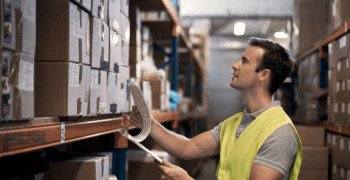
GST brings opportunities for logistics firms
Logistics means the movement of goods from point of origin to point of consumption in order to meet a customer’s requirements. It is the most important part of supply chain management and ensures the right movement in the right direction at the right time. Goods often move from one state to another, and sometimes pass through several states.
Situation of Indian logistics industry
Transportation makes up about 60% of the logistics industry, while warehousing, freight forwarding, and value-added logistics make up the remaining 40%. The Indian logistic industry, at present, is unorganized and underdeveloped.
With the implementation of GST and other reform initiatives of the central government, such as 100% FDI in warehouses and the ‘Make in India’ initiative to promote manufacturing in the country, the Indian logistics industry is expected to grow at a higher rate in next few years.
Taxability under VAT vis-à-vis GST
Different states charge VAT at different rates according to different classifications of goods in different schedules of different VAT laws. When goods enter a particular state, the respective state law authorities examine the goods, classify them according to VAT schedules, charge entry tax or octroi, and then allow entrance of the goods. A lot of time is wasted in transit, and transportation costs increase. Also, the freight is taxed several times, increasing the overall cost.
GST, which has been tagged as the “Game Changer of India in the 21st century,” will make the entire country ONE MARKET, wherein goods can freely move from one state to another without any hindrance of entry checks. The same tax rates will be charged on all products and services throughout the country, irrespective of the state where goods were manufactured or the delivery destination.
Previously, there was conflict about whether to charge VAT or service tax when leasing equipment or goods. Now, only GST will be charged, which will abolish all such conflicts.
Consolidation of warehouses
Currently, logistic companies maintain warehouses across multiple states to avoid CST and state entry taxes. Since input tax credit of CST is not admissible, it increases the overall cost.
Under GST, stock transfer has also been covered in the ambit of supply, and therefore GST will be charged whenever goods are transferred from one state to another. Logistics companies will now have an incentive to consolidate their warehouses — which now operate below capacity — resulting in overall cost efficiency. For example, companies may set up their warehouses at centrally located places such as Nagpur, a place that is well connected to the entire country.
Fuel to increase the cost
One of the most critical issues for the logistics sector remains the existence of fuel outside the scope of GST. Since state governments will continue to charge tax on fuel, it will not be eligible for input tax credit, and hence fuel will be added in the cost.
Reverse charge rules remain unchanged
GST will be payable at 100% by the recipient of the service if services are provided or agreed to be provided by a goods transport agency (GTA), with respect to transportation of goods by road to any of the following recipients:
- any factory registered under, or governed by, the Factories Act, 1948;
- any society registered under the Societies Registration Act, 1860 or any other Indian law presently in force;
- any co-operative society established by or under any Indian law;
- any person registered under CGST/SGST/UTGST Act;
- any corporate body established by or under any law;
- any partnership firm, whether registered or not, under any law, including association of persons;
- any casual taxable person
3PL & 4PL Model
Logistics companies will achieve higher growth due to lower cost, reduction in delivery time, and reduced stoppages. Companies who are struggling with their logistics may now be able to outsource their logistics operations to 3rd Party Logistics Providers (3PL) and 4th Party Logistics Providers (4PL).
In a 3PL model, a company would outsource logistics operations such as customs clearance, warehousing, order fulfillment, and distribution to a third-party logistics company.
In 4PL Model, the company outsources these operations to two or more logistics service providers and then hires another service provider specialist to coordinate the activities of the third party.
Conclusion
The Indian logistics industry is on the verge of a transformation due to the advancement of technology and the new indirect GST tax regime. Together, these advancements will reduce the current idle time and allow logistics companies to develop service cost models according to client requirements and service preferences. Logistics companies will now be able to set up their warehouses close to manufacturing plants, reducing the primary freight charges.
Though logistic companies may work hard in the short-term phase of reformulating their processes according to GST requirements, in the long term, they may reap benefits.
Avalara is an experienced application service provider (ASP) and partner of authorized GST Suvidha Providers (GSPs). To understand how our cloud-based application Avalara India GST can help you with GST compliance automation, contact us through https://www.avalara.com/in/products/gst-returns-filing.


